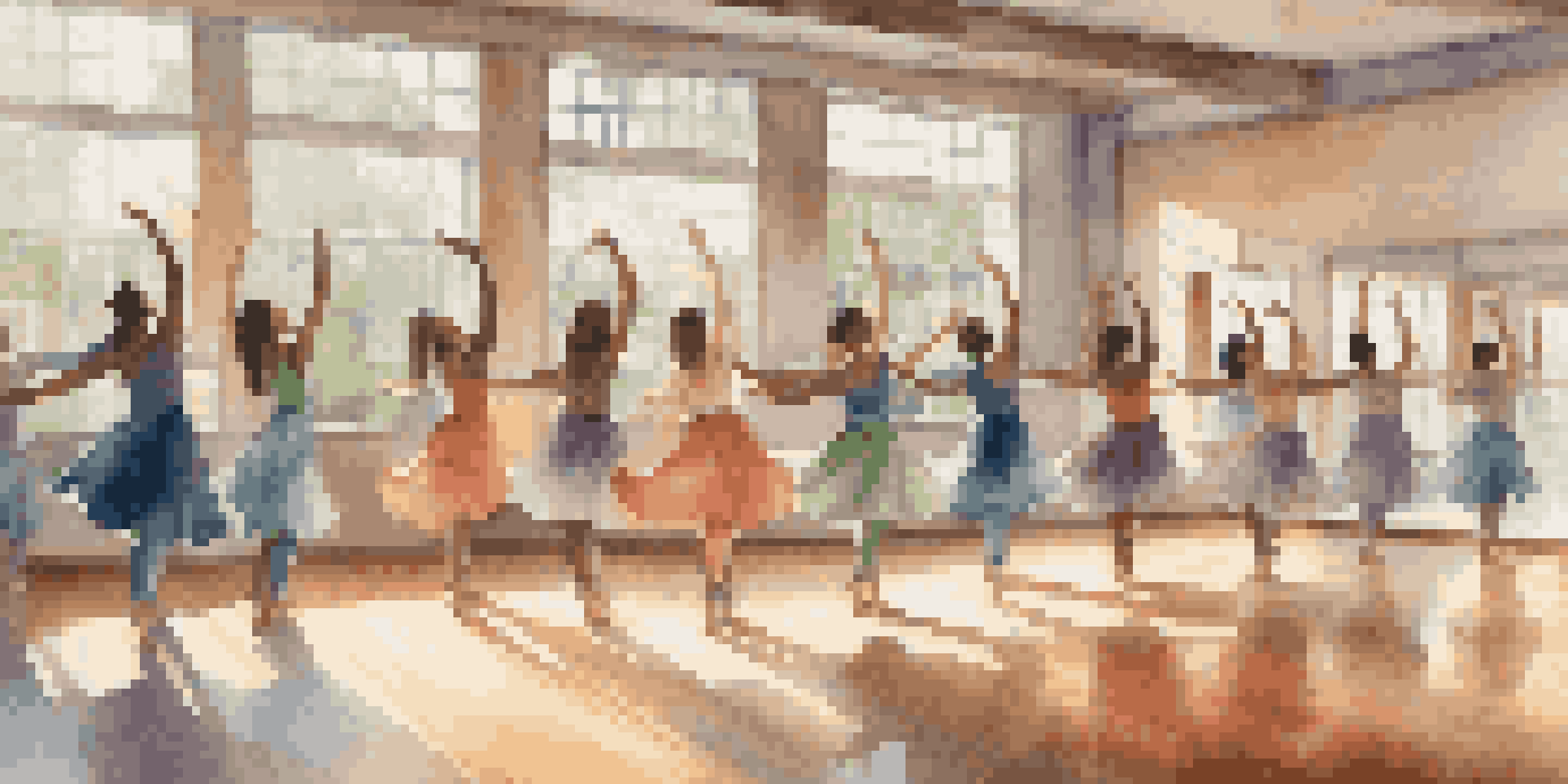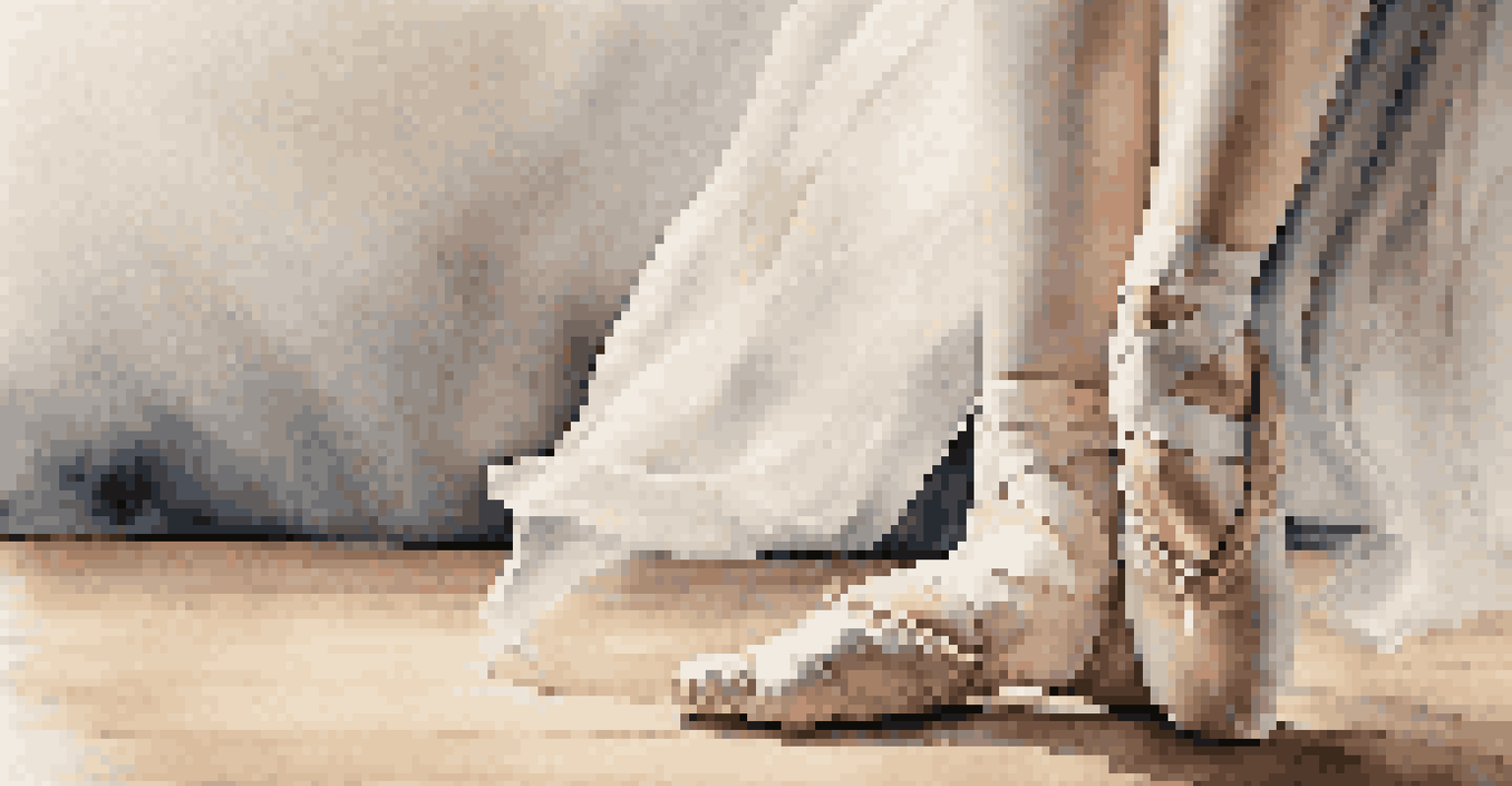Mindfulness Practices in Dance Pedagogy and Education

Understanding Mindfulness in Dance Education
Mindfulness in dance education refers to the practice of being fully present and engaged in the moment, both physically and mentally. This concept, often rooted in meditation and awareness, can significantly enhance a dancer’s experience and performance. By cultivating mindfulness, educators help students connect with their bodies, emotions, and the space around them, fostering a deeper understanding of their art.
Mindfulness isn't difficult. What's difficult is to remember to be mindful.
Incorporating mindfulness into dance pedagogy allows students to explore their physicality without the distractions of their thoughts or external pressures. For instance, a simple breathing exercise can ground students and prepare them for a more focused dance session. This practice not only improves concentration but also encourages a sense of calm, making it easier to absorb complex choreography.
Furthermore, mindfulness promotes emotional awareness, which is crucial in dance. Dancers often convey feelings through their movements; being aware of their emotions can enhance their expression and connection to the audience. When students learn to be mindful, they develop a richer, more nuanced approach to their performances, ultimately leading to greater artistic fulfillment.
Benefits of Mindfulness for Dancers
Integrating mindfulness practices into dance training offers a myriad of benefits, particularly in enhancing focus and reducing stress. Dancers often face intense pressure to perform, and mindfulness can serve as a powerful tool to manage anxiety and improve mental resilience. By regularly practicing mindfulness techniques, dancers can cultivate a calmer mindset that allows them to navigate the challenges of rehearsals and performances more effectively.

Moreover, mindfulness has been shown to improve physical performance. When dancers are present in their bodies, they can execute movements with greater precision and awareness. This heightened sense of body awareness can lead to improved technique and reduced risk of injury, as dancers become more attuned to their physical limits and capabilities.
Mindfulness Enhances Dance Education
Incorporating mindfulness helps dancers connect with their bodies and emotions, leading to improved performance and artistic fulfillment.
Additionally, mindfulness encourages a growth mindset, which is essential in any artistic endeavor. Dancers who practice mindfulness are more likely to embrace challenges and view mistakes as opportunities for learning. This shift in perspective not only enhances their dance skills but also fosters a positive learning environment where creativity can flourish.
Incorporating Mindfulness into Dance Classes
Incorporating mindfulness into dance classes doesn't require a complete overhaul of the curriculum; small adjustments can make a significant difference. For example, beginning each class with a short meditation or breathing exercise can help students center themselves and prepare for the lesson ahead. This simple act sets a tone of intentionality and presence that can carry through the entire class.
Dance is the hidden language of the soul.
Another effective method is to encourage students to focus on their sensations during movement. Instructors can prompt dancers to notice how their bodies feel as they execute different steps or sequences. This practice not only enhances their awareness but also encourages them to listen to their bodies, fostering a more intuitive approach to dance.
Lastly, creating a supportive environment where students feel safe to express themselves mindfully is crucial. Encouraging open discussions about feelings and experiences related to dance can help build trust within the class. When students feel comfortable, they are more likely to engage in mindfulness practices and explore their artistry authentically.
Mindfulness Techniques for Dance Educators
Dance educators can also benefit from mindfulness practices, as teaching can be a demanding and stressful role. Techniques such as deep breathing, visualization, or even short moments of silence can help instructors reset their minds and focus on their students. By modeling mindfulness, educators demonstrate its value, encouraging students to adopt similar practices.
Instructors can also incorporate mindful feedback techniques, emphasizing constructive criticism rather than focusing solely on flaws. For instance, highlighting what a student did well before suggesting improvements fosters a positive learning atmosphere. This approach not only builds students' confidence but also helps them develop a more mindful relationship with their own progress.
Benefits for Dancers' Well-Being
Mindfulness practices support dancers by reducing stress, enhancing focus, and promoting a positive growth mindset.
Moreover, setting intentions at the beginning of each class can help educators remain focused on their teaching goals. By reflecting on their objectives and the energy they wish to bring into the classroom, instructors can create a more cohesive and intentional learning experience for their students. This practice reinforces the interconnectedness of mindfulness in both teaching and learning.
Creating a Mindful Dance Community
Building a mindful dance community involves fostering connections among students, educators, and dancers alike. Encouraging collaboration and open communication can help create an environment where everyone feels supported and valued. This sense of community enhances the overall experience, making mindfulness a shared practice rather than an individual endeavor.
Regular workshops or group mindfulness sessions can also strengthen this community bond. These events provide opportunities for dancers to explore mindfulness techniques together and share their experiences. Such gatherings not only reinforce the practice of mindfulness but also create lasting relationships that extend beyond the dance studio.
Additionally, celebrating mindfulness achievements within the community, such as improved focus or reduced anxiety, can motivate individuals to continue their practice. Recognizing personal growth and collective progress fosters a culture of support and encouragement, further embedding mindfulness into the fabric of the dance community.
Challenges of Implementing Mindfulness in Dance
While the benefits of mindfulness in dance education are substantial, implementing these practices can come with challenges. One common hurdle is the misconception that mindfulness is only about sitting still and meditating. In reality, mindfulness can be dynamic and integrated into movement, but breaking down these barriers requires education and patience.
Additionally, some students may be skeptical or resistant to mindfulness practices. They might see it as an unnecessary addition to their training rather than a valuable tool. To address this, educators need to communicate the benefits clearly and incorporate mindfulness gradually into the curriculum, allowing students to experience its positive effects firsthand.
Building a Supportive Community
Creating a mindful dance community fosters collaboration and open communication, making mindfulness a shared practice among students and educators.
Lastly, time constraints in dance classes can pose a challenge for incorporating mindfulness. With busy schedules and a focus on technique and choreography, it may seem difficult to carve out time for mindfulness exercises. However, even brief moments of mindfulness can yield significant benefits, demonstrating that it doesn’t require extensive time commitments to make a meaningful impact.
The Future of Mindfulness in Dance Education
As the dance world continues to evolve, the integration of mindfulness practices is likely to grow in prominence. With increasing awareness of mental health and well-being, more dance educators are recognizing the importance of nurturing both the body and mind. This shift towards holistic education reflects a broader trend in the arts and education sectors, emphasizing the interconnectedness of physical and mental health.
Future dance programs may prioritize mindfulness training, offering specialized courses or workshops that focus on these practices. By doing so, they can equip dancers with valuable skills that enhance their artistry and well-being. This forward-thinking approach will not only benefit individual dancers but also contribute to a more compassionate and aware dance community.

Ultimately, the future of mindfulness in dance education holds the potential to transform how dancers approach their craft. By embracing mindfulness, the dance community can cultivate a deeper connection to the art form and foster a more supportive environment where creativity and self-expression can thrive.